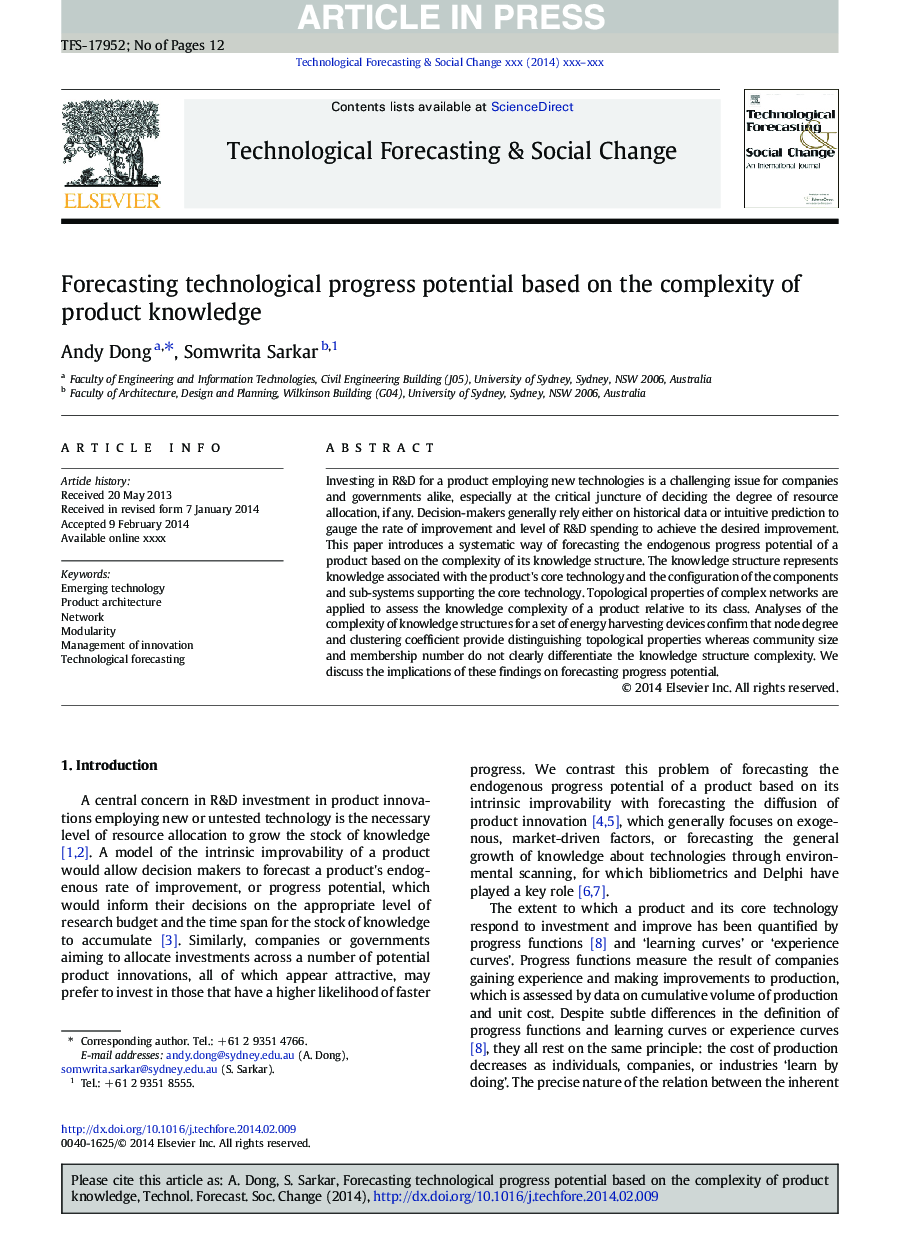| کد مقاله | کد نشریه | سال انتشار | مقاله انگلیسی | نسخه تمام متن |
|---|---|---|---|---|
| 7256978 | 1472410 | 2015 | 12 صفحه PDF | دانلود رایگان |
عنوان انگلیسی مقاله ISI
Forecasting technological progress potential based on the complexity of product knowledge
ترجمه فارسی عنوان
پیش بینی پتانسیل پیشرفت تکنولوژی بر اساس پیچیدگی دانش محصول
دانلود مقاله + سفارش ترجمه
دانلود مقاله ISI انگلیسی
رایگان برای ایرانیان
کلمات کلیدی
تکنولوژی در حال ظهور، معماری محصول، شبکه، مدولار، مدیریت نوآوری، پیش بینی فناوری،
ترجمه چکیده
سرمایه گذاری در تحقیق و توسعه برای یک محصول با استفاده از فن آوری های جدید یک مسئله چالش برانگیز برای شرکت ها و دولت ها است به خصوص در شرایط بحرانی تصمیم گیری در مورد میزان تخصیص منابع، اگر وجود داشته باشد. تصمیم گیرندگان به طور کلی بر روی داده های تاریخی یا پیش بینی های بصری تکیه می کنند تا میزان بهبود و میزان هزینه های تحقیق و توسعه برای دستیابی به بهبود مورد نظر را ارزیابی کنند. این مقاله یک روش سیستماتیک پیش بینی پتانسیل پیشرفت درونی محصول را بر اساس پیچیدگی ساختار دانش آن معرفی می کند. ساختار دانش نشان دهنده دانش مرتبط با فن آوری هسته محصول و پیکربندی اجزا و زیر سیستم هایی است که از تکنولوژی هسته پشتیبانی می کنند. خصوصیات توپولوژیکی شبکه های پیچیده برای ارزیابی پیچیدگی دانش یک محصول نسبت به کلاس آن اعمال می شود. تجزیه و تحلیل پیچیدگی ساختارهای دانش برای مجموعه ای از دستگاه های برداشت انرژی تایید می کند که درجه گره و ضریب خوشه بندی خواص توپولوژیکی مشخصی را در بر می گیرد در حالیکه اندازه جامعه و تعداد اعضای آن به وضوح پیچیدگی ساختار دانش را متفاوت می کند. ما در مورد پیامدهای این یافته ها در پیش بینی پتانسیل پیشرفت بحث می کنیم.
موضوعات مرتبط
علوم انسانی و اجتماعی
مدیریت، کسب و کار و حسابداری
کسب و کار و مدیریت بین المللی
چکیده انگلیسی
Investing in R&D for a product employing new technologies is a challenging issue for companies and governments alike, especially at the critical juncture of deciding the degree of resource allocation, if any. Decision-makers generally rely either on historical data or intuitive prediction to gauge the rate of improvement and level of R&D spending to achieve the desired improvement. This paper introduces a systematic way of forecasting the endogenous progress potential of a product based on the complexity of its knowledge structure. The knowledge structure represents knowledge associated with the product's core technology and the configuration of the components and sub-systems supporting the core technology. Topological properties of complex networks are applied to assess the knowledge complexity of a product relative to its class. Analyses of the complexity of knowledge structures for a set of energy harvesting devices confirm that node degree and clustering coefficient provide distinguishing topological properties whereas community size and membership number do not clearly differentiate the knowledge structure complexity. We discuss the implications of these findings on forecasting progress potential.
ناشر
Database: Elsevier - ScienceDirect (ساینس دایرکت)
Journal: Technological Forecasting and Social Change - Volume 90, Part B, January 2015, Pages 599-610
Journal: Technological Forecasting and Social Change - Volume 90, Part B, January 2015, Pages 599-610
نویسندگان
Andy Dong, Somwrita Sarkar,
